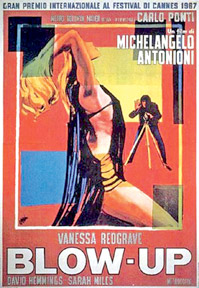|
Julio Cortázar and Michelangelo Antonioni::
‘Blow up and Other Stories’: Cortázar's influence on Cinema
 'Blow-Up and Other Stories' is a collection of short stories, written
by Argentinian author Julio Cortázar, who wrote 'Rayuela' (Hopscotch),
reviewed last week. The title story of the collection served as
inspiration for Michelangelo Antonioni's film title 'Blow-up'.
Cortázar's 'Blow-up' is one of his best known short stories and in spite
of the extraordinary amount of commentary dedicated to it, it still
remains one of his most problematic. 'Blow-Up and Other Stories' is a collection of short stories, written
by Argentinian author Julio Cortázar, who wrote 'Rayuela' (Hopscotch),
reviewed last week. The title story of the collection served as
inspiration for Michelangelo Antonioni's film title 'Blow-up'.
Cortázar's 'Blow-up' is one of his best known short stories and in spite
of the extraordinary amount of commentary dedicated to it, it still
remains one of his most problematic.
There are many things that are confusing. The hesitancy around the
person of the narrator, the grammatical permutations, the mixture of
first and third person narration, the double time of the narrative
(first the original scene at the parapet of the Quai de Bourbon and then
the repetition of the scene in the fifth floor apartment of the
writer/photographer Roberto-Michel).
|

Michelangelo Antonioni |
There is also the rotation of the subject positions taken up by the
boy, the blond woman, the man in the grey hat and Roberto-Michel
himself. Finally the 'dead' (and alive) status of the narrator at the
end of the story. It is true that many of these structural and narrative
effects or devices are to be found in many of Cortázar's other short
stories. Julio Cortázar's "Las Babas del Diablo" (the Devil's Drool) is
the acknowledged precursor of Michelangelo Antonioni's Blowup (1966),
rather than his short story 'Blow-up' (which inspired the style and the
title). This type of writing is typical of the Boom era, which I have
been exploring for several weeks.
In the Antonioni film, a photographer, Thomas (David Hemmings), blows
up a photograph and discovers a hidden gunman in the bushes. Thomas
initially believes his photograph saved an old man from being murdered
but discovers later that the murder happened anyway. In the Cortázar
short story, a photographer thinks he has captured the bittersweet
seduction of an adolescent by an older woman only to discover to his
horror that she is "pimping" him for a dirty old man waiting in a nearby
automobile.
Moving into the surreal, the photograph becomes a movie or rather a
photomontage of moving figures. In a further transformation, the
photographer is drawn into the slow motion of the photo montage. He
becomes his camera, becomes the seduced boy and yet remains himself. It
is while he is in this tripartite state that he is murdered by the old
man and lies dead in the photograph staring at the sky as camera, boy
and photographer are all rolled into one.
The film begins the day after Thomas spends the night at a doss house
where he has taken pictures for a book of art photos he hopes to
publish. He is late for a photo shoot at his studio with 60's supermodel
Veruschka, which in turn makes him late for another photo shoot with
many other models later in the morning. He grows bored and walks off the
shoot (also leaving the models and production staff in the lurch).
|

Blow-Up Movie Poster |

Image from Blow Up 1966 |
Exiting the studio, two girls, aspiring teenage models (Jane Birkin
and Gillian Hills), ask to speak with him butThomas drives off to look
at an antiques shop which he might buy. He then wanders into nearby
Maryon Park where he sees two lovers and takes photos of them. The woman
(Redgrave) stalks Thomas back to his studio, asking for the film. This
makes him want the film even more, so he misleads her into taking
another roll instead. He makes many blowups (enlargements) of the black
and white photos.
These blowups have very rough film grain but nonetheless seem to show
a body lying in the grass and a killer lurking in the trees with a gun.
Thomas is frightened by a knock on the door but it is only the two
girls again, with whom he has a romp in his studio and falls asleep.
Awakening, although they hope he will photograph them then and there, he
tells the girls to leave. Both film and story are meditations on
aesthetics and morality. Although the Spanish title ("Las Babas del
Diablo") is a colloquial phrase meaning to be in a dangerous situation.
However, Cortázar enjoys wordplay, and seems to be suggesting with the
title that the camera is a drooling devil - a lustful voyeur that is
capable only of lifeless illusion and is ultimately impotent. In the
story, Cortázar's narrator writes:
I think that I know how to look, if it's something I know, and also
that every looking oozes with mendacity, because it's that which expels
us furthest outside ourselves.
Later the photographe r/narrator expresses his rage:
It was horrible, their mocking me, deciding it before my impotent
eye, mocking me and I couldn't yell for him to run.
It would appear that Cortázar and Antonioni are saying that our media
is inherently alienating and dehumanizing. The camera has turned us into
passive voyeurs, programmable for predictable responses, ultimately
helpless and even inhumanly dead. These are dark thoughts indeed, but
the work of Cortázar and Antonioni are not exactly known for their
optimism.
As The Yardbirds perform in the nightclub, the eerily mute crowd is
so still that some of the people may not be people at all, but
department store mannequins or wax figures. If this is true, it fits
well with the mannequins in the window just outside the club and with
the plastic family enjoying their desert home in Antonioni's 'Zabriskie
Point' (1970). Either way, with the odd stillness of the crowd,
Antonioni is trying to get at the heart of the Cortázar story.
Rather than liberating us, our technologically driven art forms
(cinema, photography, and rock and roll) are finally numbing and
paralysing us because they seem to require passivity of their audiences.
At the very least, passivity is encouraged. In an Antonioni film, Jeff
Beck destroying his amp and guitar is not merely a realistic cultural
detail, it is symbolic of the artist's rage against his tools, which are
isolating, denaturing and incapable of conveying a clear vision, of
changing or influencing the quotidian. Caught up with the
media-controlled crowd, Thomas joins the scrambles for the guitar-neck
totem but discards it as meaningless once he is alone. He works
frantically to blow up photos and discover hidden truths. Once
discovered he lets them drift away.
Thomas goes to a party to raise interest in his murder case but fails
in an ending that is even darker than Cortázar's story. In the story,
the narrator may be dead, but at least his art was able to discover the
truth and the photographer was able to empathize and identify with the
victim to the point of dying in his place, surely a positive outcome for
a work of art. In Antonioni's film, nothing is done, nothing is learned
and nobody cares. "A murder? So what!" his characters seem to say. In a
dialogue of total emptiness, Thomas talks to his stoned editor, Ron
(Peter Bowles):
Thomas: I want you to see the corpse. We've got to get a shot of it.
Ron: I'm not a photographer.
Thomas: I am.
Ron (muttering to himself as if Thomas has left the room, although he
hasn't): What's the matter with him? What did you see in that park?
Thomas (sighing): Nothing.
Seeing justice done is never a goal. It becomes clear that Thomas'
goals have always been completely aesthetic. When Thomas returns to the
park for the shot he wants to finish out his book, he discovers the body
gone. He smiles wryly. Art for him is an illusion, nothing more than a
game of make-believe where we can dream away our lives in childish play.
The real world is even less than that - it's not even amusing. At the
end of Cortázar's story, we discover that the narrator is dead,
immobilized, metamorphosed into the very lens of the camera as it views
the world as a photograph. It appears that Antonioni reaches the same
conclusion with his justly famous ending.
When Thomas stoops to retrieve and toss an imaginary tennis ball back
into the mime game, he enters the frame of art, leaves reality and
ceases to be himself in pursuit of pure ćsthetics. The camera pulls back
to show Thomas walking utterly alone across a vast green field. Using a
dissolve, Antonioni causes him to suddenly disappear like the ghost he
has become.
The two American versions of the story are a copy of a copy which all
but obliterate the original Cortázar story. They switch from photography
to sound, but the inability of technology to intelligently capture
nature and the ontological merging of artist and medium are still the
prevailing themes. In Francis Ford Coppola's The Conversation (1974),
Harry Caul (Gene Hackman), becomes convinced that his surveillance tape
will result in the deaths of the young couple he has recorded as they
walk through San Francisco. The festival atmosphere, is clearly a subtle
nod to Antonioni but the disturbing ending suggests the influence of
Cortázar. Harry discovers that he has been completely wrong and has
inadvertently helped the couple commit murder. Finally, they turn his
technology on him as he is drawn into his own "aural photograph", and is
left as paralysed and impotent as Michael in the Cortázar tale.
In Brian De Palma's 'Blow Out' (1981), Jack (John Travolta) captures
a sound that equals the murder of a presidential hopeful. Unlike
Antonioni's amoral protagonist, Jack is driven by a desire to do what is
right, much like Harry in 'The Conversation' and Michael in 'Las Babas
del Diablo'. However, also like them, he solves nothing and saves no
one; he only discovers his own impotence.
Plus his defeat results in his own moral corruption, a conclusion
suggested more by Cortázar than Antonioni. Jack works as a soundman for
cheap horror movies and "Blow Out" opens with him criticising a "bad
scream" used in a shower knifing sequence. When Manny (Dennis Franz)
murders Jack's love interest, Sally (Nancy Allen), Jack is close enough
to record her scream but not to save her life. In the closing scene of
the film, we see the ruined hero listening to her scream which has been
as the needed scream for the horror flick - a snippet of aural snuff.
Jack has merged with his technology and has blurred reality and fiction
so that the real no longer matters and the fiction is not even good art.
All four tales make the same point - art is impotent to do anything but
corrupt the artist. |

